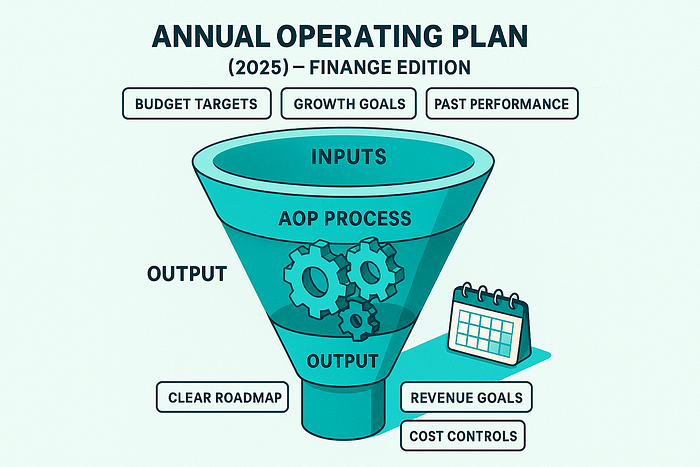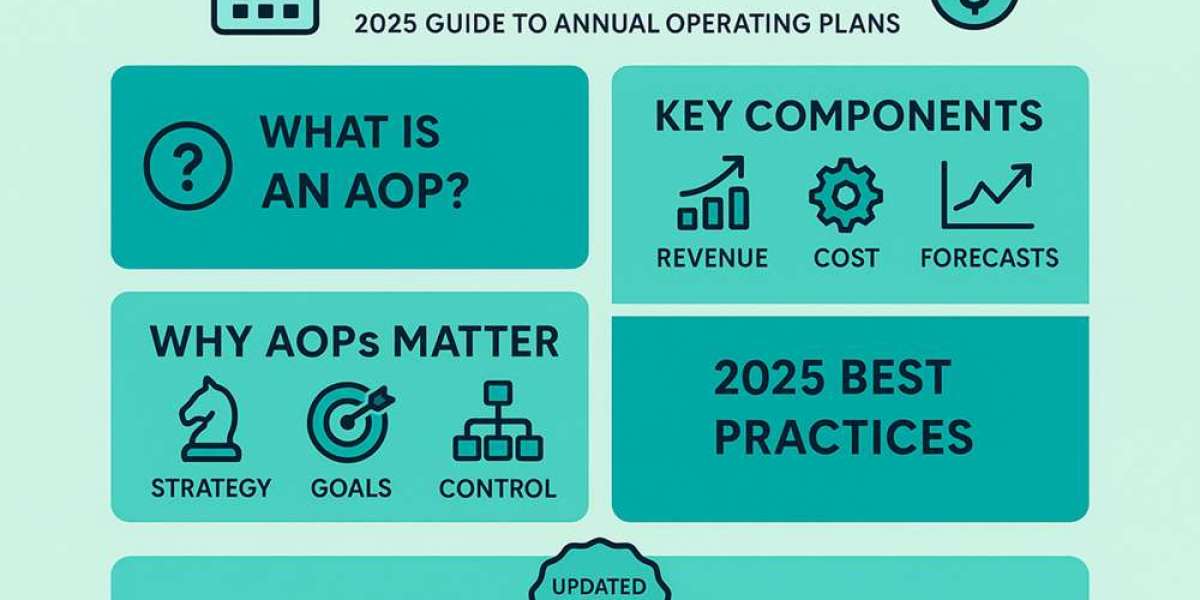I’ve watched too many finance teams spend January building elaborate budgets, only to watch them become irrelevant by March. The spreadsheet sits pristine and untouched while the actual business runs on gut feeling and last-minute pivots.
After fifteen years helping companies transform their financial planning, I can tell you the difference between organizations that execute their strategy and those that don’t comes down to one thing: they treat their Annual Operating Plan as a living execution system, not a compliance document.
Let me walk you through what AOP in finance actually is, why it matters more than ever in 2025, and how to build one that drives real results instead of gathering digital dust.
Quick Answer: What is AOP in Finance?
AOP in finance stands for Annual Operating Plan — a comprehensive 12-month roadmap that translates your company’s strategic vision into specific financial targets, operational goals, and departmental initiatives, complete with budgets, KPIs, and clear accountability measures for the fiscal year ahead.
Think of it as the bridge between where you want your business to go and the concrete steps you’ll take this year to get there.
Understanding AOP in Finance: More Than Just a Budget
Here’s where most companies get confused: they treat their AOP like an elaborate budget spreadsheet. But a budget tells you how much money goes where, while AOP in finance tells you what you’re going to accomplish with it and why it matters.
I recently worked with a mid-market healthcare company that had departmental budgets but no unified operating plan. During our AOP process, we discovered three departments had independently budgeted for different CRM systems, completely unaware they were competing for the same implementation resources. We caught this disconnect in December rather than discovering it in April when projects started colliding.
An effective AOP in finance includes your financial projections broken down by revenue segment, operational objectives like customer acquisition targets and product launches, strategic initiatives that advance your multi-year goals, resource allocation across headcount and technology, performance metrics you’ll track monthly, and a clear accountability framework showing who owns what.
The companies that consistently hit their targets share one characteristic: they use their AOP as an operating system rather than treating it as an annual ritual.
Why Your Finance Team Needs AOP in Finance for 2025
Alignment prevents expensive mistakes. According to research from Deloitte’s Q4 2024 CFO Signals survey, 42% of CFOs prioritize enterprise risk management in 2025 alongside cost optimization. Without AOP in finance, different departments make independent assumptions that don’t align, leading to sales plans that operations can’t support and marketing campaigns for products that aren’t ready.
Performance tracking becomes objective. With AOP in finance, your quarterly business reviews focus on actual performance against established targets. Without one, these meetings devolve into storytelling sessions where everyone explains why their missed targets aren’t really missed if you think about them differently.
Mid-year pivots happen faster. When market conditions shift, companies with scenario-planned AOPs can activate contingency plans within weeks instead of spending months debating whether to cut costs and which ones to prioritize.
I’ve seen this firsthand with financial services clients implementing our financial analytics solutions. Those with robust AOPs could adjust their investment strategies and resource allocation in real-time when economic indicators changed, while competitors were still scheduling emergency planning sessions.

AOP vs Budget vs Strategic Plan: Critical Differences
Your Strategic Plan covers three to five years and answers “Where are we going and why?” It defines your long-term vision and competitive positioning.
Your AOP in finance covers 12 months and answers “What will we accomplish this year to advance our strategy?” It includes specific initiatives with clear owners, timelines, and success criteria.
Your Budget covers 12 months and answers “How much money goes where?” It provides line-item financial detail by department.
The relationship works like this: Your strategic plan sets direction, your AOP in finance translates that direction into this year’s priorities, and your budget provides financial boundaries for executing the AOP.
Essential Components Every Effective AOP in Finance Needs
After reviewing AOPs from dozens of organizations, the strongest ones consistently include these elements:
Executive Summary: Your board will read this, maybe only this. Capture your top three to five priorities, critical market assumptions, major resource needs, and expected financial outcomes in one to two pages.
Strategic Objectives: Cascade these from your strategic plan. Make them specific — “Increase NPS from 38 to 50 through faster onboarding and round-the-clock support” beats vague goals like “improve customer satisfaction” every time.
Financial Projections: Build your revenue forecast by segment, expense budget by department with headcount assumptions, cash flow projections, and key financial ratios. Creating at least two scenarios makes mid-year adjustments less painful.
Departmental Operating Plans: Each function details their objectives, major initiatives, resource needs, key metrics, and dependencies on other teams. This is where cross-functional alignment actually happens. For organizations in financial services, these plans need to account for regulatory requirements and compliance frameworks that other industries can treat as secondary.
Key Performance Indicators: Mix leading indicators like pipeline coverage with lagging indicators like revenue and churn. If you’re implementing analytics dashboards to track these metrics, make sure the KPIs in your AOP match what your systems will actually monitor.
Resource Requirements with Timing: Don’t just say “hire twelve people” — specify “add two SDRs in Q1, three customer success managers in Q2, four engineers in Q3.” This specificity drives accountability.
Risk Assessment: Document your top three to four risks with likelihood, potential impact, and response plans. Companies that had these scenarios documented in early 2020 could activate contingency plans in March, while those without spent weeks arguing about what to do.
Building Your AOP in Finance: A Practical Approach
Start by reviewing last year’s performance before planning forward. Gather results, identify what drove outcomes both positive and negative, note what surprised you, and discuss what you’d do differently.
Use analytics approaches to identify patterns in historical performance. Descriptive analytics shows what happened, diagnostic analytics reveals why, and predictive analytics suggests what might happen again.
Set your top-line objectives using your strategic plan as context. Get executive alignment on the three to five most critical outcomes before proceeding. Everything flows from these commitments.
Then gather bottom-up departmental plans. The first pass always reveals misalignments — sales forecasts one number but marketing’s plan supports something different. Surface these conflicts explicitly in December rather than discovering them mid-year.
Build your consolidated financial model by translating departmental inputs into a complete profit and loss statement. This is where reality testing happens. For companies using demand forecasting techniques, this step benefits enormously from predictive models that account for seasonality and market trends.
Model multiple scenarios because your base case will be wrong. Build conservative and stretch cases so you’ve already thought through response options instead of making pressured decisions later.
Expert Industry Perspective
“Scenario planning is something we’ve always done, but the current environment has caused us to really accelerate the way we do it… now, we’ve been running models and doing analysis almost daily.” — David Chojnowski, Corporate Controller and Chief Accounting Officer, Walmart | Deloitte Program
Common AOP in Finance Pitfalls to Avoid
Top-down targets with no validation: The CEO announces ambitious growth without checking if the organization has capacity. Solution: Start with aspirations but require validation, then explicitly address any gaps.
Planning in silos: Each department builds independently, leading to mismatched assumptions. Solution: Use cross-functional planning sessions where teams present to each other and surface disconnects in real-time.
Static scenario planning: You create one forecast, lock it in January, and refuse to revisit when reality diverges. Solution: Review quarterly, update assumptions when they change materially, and reforecast based on actual results.
Modern business intelligence solutions make continuous monitoring possible by automating KPI tracking and variance analysis, freeing your finance team to focus on interpretation rather than data gathering.
Making Your AOP in Finance Work: Execution Matters
The biggest mistake I see is treating AOP in finance as a January deliverable that gets filed until December. Your AOP should drive monthly leadership meetings to review key metrics and discuss variances, quarterly business reviews for deep dives on performance and assumption reassessment, and mid-year reforecasting to update projections based on first-half actuals.
Companies that execute well involve stakeholders early, balance ambition with realism grounded in data, connect every initiative to strategic objectives, and communicate relentlessly about progress and adjustments.
According to Deloitte’s research on CFO priorities, 40% of CFOs prioritize digital transformation of finance in 2025. Organizations leveraging modern FP&A tools can streamline AOP creation, enable robust scenario planning, and automate progress tracking.
Your Path Forward with AOP in Finance
An Annual Operating Plan transforms strategic aspirations into executable reality. It’s not just another planning document — it’s the operating system that drives priority-setting, resource allocation, and accountability across your organization.
If you don’t have a formal AOP in finance, commit to building one for next year. If you have one gathering dust, recommit to making it your operational centerpiece.
The difference between companies that execute well and those that struggle isn’t better strategy — it’s a better system for translating strategy into action. The Annual Operating Plan is that system.
For a deeper dive into building effective AOPs with real-world examples and step-by-step guidance, check out our comprehensive guide: What is AOP in Finance? Annual Operating Plan Guide 2025
Ready to transform your financial planning process? Our team specializes in helping finance leaders build and execute AOPs that drive measurable results. Contact us to discuss how we can support your planning initiatives.
Looking to enhance your financial analytics capabilities? Explore our comprehensive financial analytics solutions designed specifically for growing organizations that need strategic financial insights.



